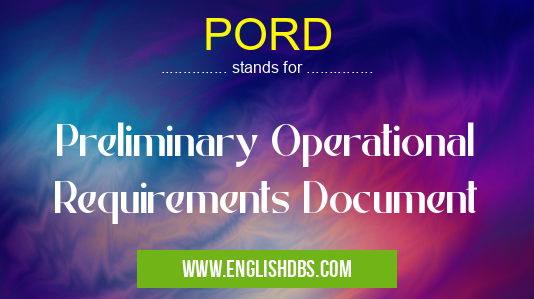What does PORD mean in UNCLASSIFIED
PORD stands for Preliminary Operational Requirements Document. It is a document that defines the initial set of requirements for a new or modified system, product, or service. PORDS are typically used to establish a baseline for development and to ensure that the end product meets the needs of the stakeholders.

PORD meaning in Unclassified in Miscellaneous
PORD mostly used in an acronym Unclassified in Category Miscellaneous that means Preliminary Operational Requirements Document
Shorthand: PORD,
Full Form: Preliminary Operational Requirements Document
For more information of "Preliminary Operational Requirements Document", see the section below.
Key Points
- PORDS are developed early in the development lifecycle, typically during the requirements gathering phase.
- They are based on stakeholder input, including users, customers, and subject matter experts.
- PORDS provide a high-level overview of the system's functionality, performance, and other characteristics.
- They are often used as a basis for creating more detailed specifications and design documents.
- PORDS can help to ensure that the end product meets the needs of the stakeholders and is aligned with the organization's strategic goals.
Benefits of Using PORDS
- Improved communication: PORDS help to ensure that all stakeholders have a clear understanding of the system's requirements.
- Reduced risk: PORDS can help to identify and mitigate potential risks early in the development process.
- Increased efficiency: PORDS can help to streamline the development process by providing a clear roadmap for the team.
- Enhanced quality: PORDS can help to ensure that the end product meets the desired quality standards.
Essential Questions and Answers on Preliminary Operational Requirements Document in "MISCELLANEOUS»UNFILED"
What is a PORD?
A PORD (Preliminary Operational Requirements Document) outlines the initial capabilities and performance requirements for a proposed system or project. It provides a framework for the system's development and ensures that it meets the intended operational needs.
What information is typically included in a PORD?
A PORD generally includes a description of the system's purpose, its intended users, the required performance parameters, any constraints or limitations, and a timeline for development and deployment.
Who is involved in developing a PORD?
The PORD is usually developed by a team that includes stakeholders from the user community, system engineers, and project managers.
What is the purpose of a PORD?
The primary purpose of a PORD is to establish a clear understanding of the operational requirements and to guide the design and development process. It serves as a baseline for assessing the system's progress and ensuring that it meets user expectations.
How does a PORD differ from a SORD (System Operational Requirements Document)?
A PORD is a preliminary document that outlines the initial requirements, while a SORD is a more comprehensive document that details the final operational requirements for the system. The SORD is typically developed after the PORD is completed and approved.
Final Words: PORDs are an essential tool for any organization developing a new or modified system. They provide a clear and concise overview of the system's requirements, helping to ensure that the end product meets the needs of the stakeholders.
